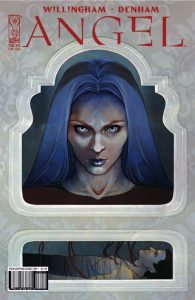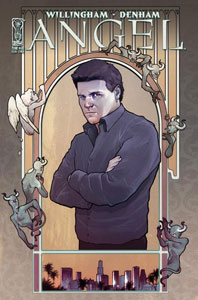The first 27 issues of IDW’s main “Angel” title were collected under the “Season Six” banner, and that works out well because writer Bill Willingham’s run on the series from Issues 28-35 (December 2009-July 2010) feels like the launch of a new season – in a good way. While “After the Fall” (Issues 1-17) was strong, the title lost focus and momentum after that. Willingham, working with artists Brian Denham (28-32) and Elena Casagrande (33-35), brings a confident sense of direction to what I like to call “Season Seven.” And the artists also draw a Kate who looks like Kate for the first time in too long.
The story is serialized, much like Seasons 3 and 4, and Willingham hands off the reins before reaching his own narrative conclusion. But there are a lot of strong threads and issues that would stand as above-average episodes of the TV series.
“Bedroom Follies” (34) is on the short list of IDW’s best “Angel” issues, and certainly one of the funniest. Illyria is in heat and making a case to Connor as to why he should procreate with her. Her influence extends throughout the Hyperion Hotel, so Kate and Angel also pair up in a hilarious series of panels where she is talking about her day while stripping in his bedroom. The joke extends to Spike and Laura Weathermill, an ageless Watcher who has somewhat aggressively joined Angel Investigations. And then Dez is invited into a threesome with Angel and Kate.
Willingham’s issues play like a conscious course correction, but he doesn’t drop unwanted characters without ceremony. Wisely, the writer makes use of James, giving us the twist that he is not the good angel he claims to be, but rather an interdimensional being who holds the deed to Earth. “Letters Home: A Jamesian Interlude” (33) is smartly structured: We read the correspondence between James and his sister as he wrangles the terms of his acquisition of Earth. Meanwhile, he magically creates a soul-sucking golem to go after our heroes. (Willingham doesn’t do nearly as much with the jaguar shapeshifter Dez, the other newcomer from the previous batch of issues, but she’s still at Angel Investigations, available for future use.)

Willingham also finds good material for our old favorites. Illyria is naturally interesting, but by this point, her internal struggles over being human have been covered. It’s still good for laughs, sure, but it’s nice to see a next step in her arc as she aims to produce offspring. Granted, that’s also a source of laughs, not only in “Bedroom Follies” but also in the previous issues. She is sitting atop Angel, who is encased in a living coffin of sorts, and asking his permission to court Connor. Amusingly, Angel can listen but not speak.
Issues 28-32 tell a complete tale in addition to having ongoing serial elements. Willingham ends “The Crown Prince Syndrome” (28) with a cliffhanger of Angel being trapped in this cocoon-like state. Then flashbacks bring us up to speed, and the thread plays out. Willingham revisits an idea that dates back to “Eternity” (1.17). In that episode, an actress wants Angel to turn her into a vampire so she’ll have an immortal career. These five issues are a more robust take on that concept. Angel turns down a Hollywood agent who offers riches in exchange for siring celebrities, so the agent moves to Plan B: He captures Angel and uses his blood to sire the celebs.

It’s not totally clear how this works, but one thing is for sure: A transfusion of Angel’s blood does not give these newborn vampires souls. In “The Trouble with Felicia” (30), the titular celebrity vampire appears on a daytime talk show and ends her segment by ripping out the host’s throat. It feels like a conscious rebuttal to similar scenes in “Buffy” Season 8, published just before this, where Harmony disseminates her message that vampires can be good people.
Speaking of souls, Willingham concludes “Prophet for Profit, Part One” (35) with a zinger: James’ soul-sucking golem doesn’t attack Spike because, she says, he doesn’t have a soul. Could it be that Spike never did get a soul after “Buffy” Season 6, and only thought he did? After all, Harmony doesn’t have a soul and she does pretty well at finding interests other than killing. The same situation probably does not apply to Spike, but it’s a heck of a cliffhanger for the next “Angel” writing team to pick up. (Willingham helps out by sticking around as a co-plotter on upcoming issues).
Some things in this batch don’t work as well. A team of demon hotties volunteers to join Connor (who leads Angel Investigations while Angel is missing) in killing as many vampires as possible in Los Angeles. It’s a random development, as is Laura’s sudden arrival as the team’s research expert and the fact that her assistant is a sentient computer ball that hovers at her side. (Granted, floating fish telepath Betta George is still around too, so there is a Joss Whedon-approved precedent for weirdness.)
Although not as herky-jerky as “Aftermath” (18-22), Willingham’s narrative jumps around to various threads, giving too much weight to some events and not enough to others. Connor and Gunn hate each other’s guts, which is not illogical, but it comes out of nowhere. Gunn accurately lists Connor’s past faults and departs the hotel for good. Throughout IDW’s “Angel” run, I’ve gotten close to liking Connor (at least more than his TV version), but when Connor criticizes others without being able to acknowledge his own faults, it’s hard to embrace him.
Gunn also pops up in the backup strips in these issues, written by Bill Williams and starring a blue horned devil named Eddie Hope. Like Connor, vigilante vampire hunter Eddie loathes Gunn for his actions as a vampire in “After the Fall,” but he aims to take it a step further and kill Gunn. The two are fighting when we leave off in Issue 35.
The Eddie Hope strips aren’t enjoyable to read in short bursts, and there’s one issue where Gwen makes a cameo that would be welcome except that it makes no sense. It’s as if IDW feels bad for bumping Gwen from the main cast. (But at least we know she has been shunned by Connor. In contrast, the disappearance of Nina post-“After the Fall” is totally unexplained.) IDW thinks a lot of Eddie Hope, though, as he’s featured on alternate covers throughout this run, and he’ll later join Spike in “The Devil You Know” miniseries. At this point, I’m not yet won over.
The Willingham run: 4 stars
Eddie Hope backup story, Issues 28-35: 2 stars
Click here for an index of all of John’s “Buffy” and “Angel” reviews.

